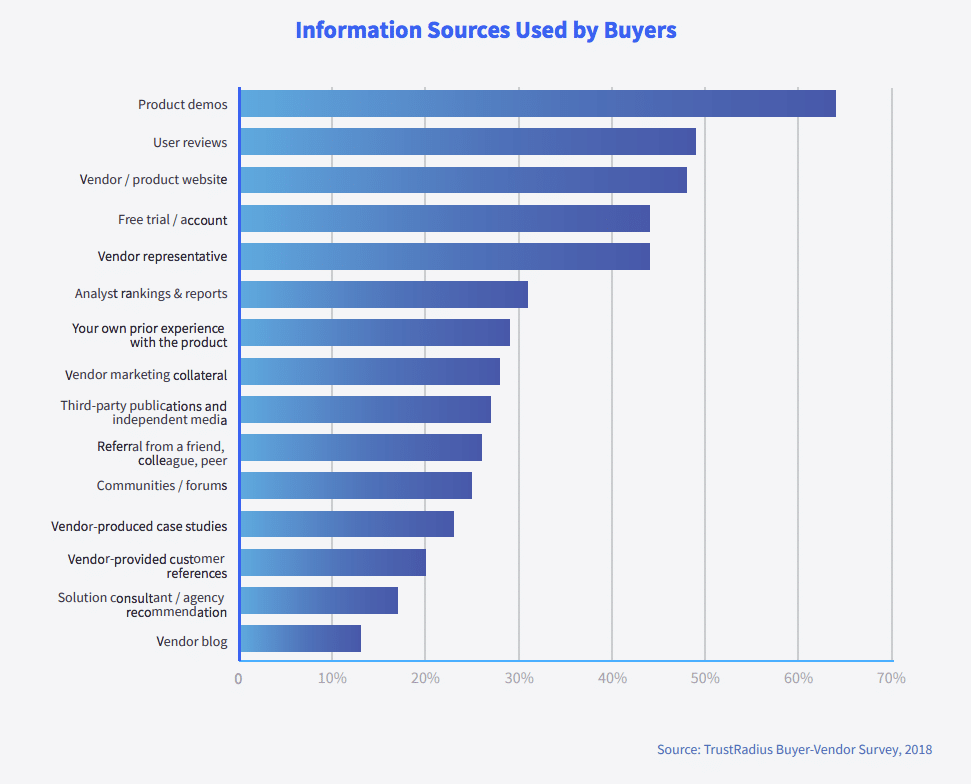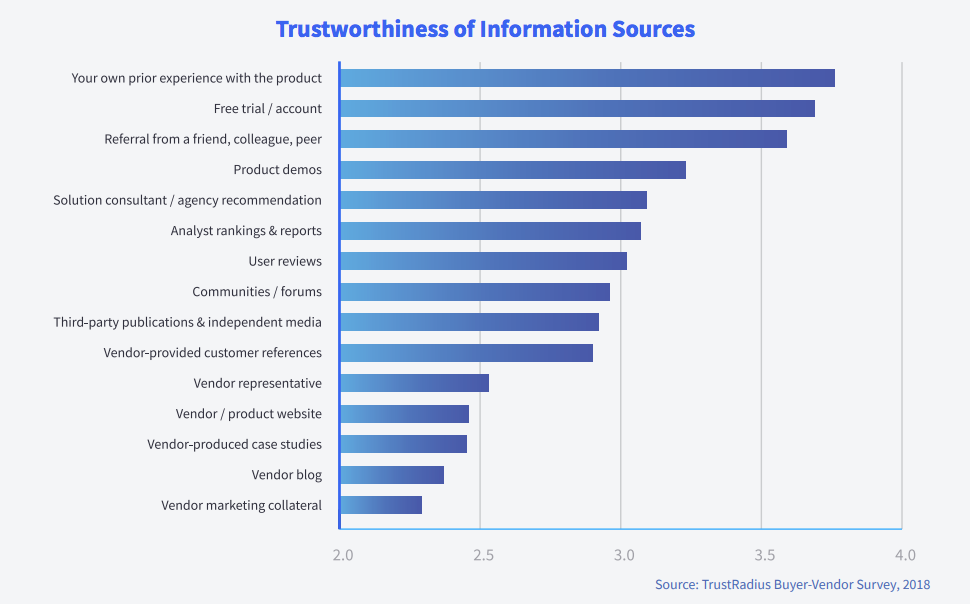A new report from B2B review platform TrustRadius reveals that tools and software vendors who are more honest and open about their products—and dial down the slick sales messaging that most stick to like glue—are more likely to close the deal. The study, 2018 B2B Buying Disconnect, was designed to explore the evolving relationship between technology buyers and vendors.
More than 650 technology buyers and vendors took aligning surveys on the B2B purchasing process that covered how buyers make purchasing decisions, what information sources buyers use and trust, what information sources vendors provide and believe are effective, and how vendors can be more influential during the purchasing process.
“The way we can now communicate via the internet, sharing our thoughts and experiences without a filter, has a big impact on the buying process,” said survey participant Scott Rosen, vice president of technology at Guardian Credit Union, in a news release. His team recently made a six-figure investment in IT infrastructure, and he ranked user reviews and references as the most influential and trustworthy resources.
Rosen also noted that the vendor was very forthcoming about the product’s limitations, and proactively provided his team with unbiased customer evidence during the sales cycle. “I have no problem with account reps, and our sales person was top notch, but they drink the kool-aid—they are always going to sell the product and talk it up.”
The results showed that trust—or a lack thereof—is critically important when it comes to buying big-ticket B2B software. So is candor. Buyers reported that the most common ticket price was $11,000-$50,000 per year, and 23 percent reported spending over $100,000 per year. The data underlined why every buying decision can have serious financial and career consequences, and why CTOs, CIOs and other decision-makers prefer vendors who they believe are completely straightforward, to the point of openly discussing product faults.
“Mainstream sites are plagued with fake and shallow reviews, which might be fine if you’re looking for a restaurant, but is unacceptable if you’re making a $50,000 purchase,” said Vinay Bhagat, CEO and founder of TrustRadius, in the release. “The results of this study highlight why we are defining the next generation of reviews with a focus on authenticity and quality—every reviewer is verified, every review is vetted, the average review is over 400 words, and we don’t sell ads or leads. Buyers need a trusted partner in the buying process, especially when vendors are not stepping up. Perhaps one day consumer-facing review sites will follow in our footsteps.”
Key findings and takeaways from the study include:
There is a trust gap between vendors and buyers
While vendors believe they are transparent, most buyers don’t see it. Eighty-five percent of vendors say they are open about their product’s limitations during the sales process. However only 37 percent of buyers thought their vendor lived up to that promise.
Candor is directly linked to influence
When vendors do relinquish control of the message, they are rewarded. Only 23 percent of buyers said the vendor was highly influential in their purchasing decision, and those vendors were twice as likely to embrace authenticity than the rest. Of the buyers who worked with a very influential vendor, 56 percent said the vendor was upfront about product limitations (versus 31 percent of buyers with less influential vendors), 50 percent said the vendor provided customer evidence like reviews and case studies (versus 27 percent) and 42 percent said they were connected with customer references (versus 20 percent).
Peer reviews rise to the top
So who do people trust? Other people like them—their colleagues and peers. But relying on your own personal network is often too limiting, and buyers realize that vendor references and case studies have built-in bias. Reviews allow buyers to crowdsource recommendations without the spin. This year reviews moved from the fifth to second most popular information source during the selection process, topped only by product demos and surpassing vendor websites, free trials and vendor representatives.
Customers are willing to help—if you ask
B2B buyers want feedback, but they are also open to sharing feedback to help their peers. 84 percent said they would be willing to share their perspective with other buyers. Yet vendors still aren’t taking advantage of this customer goodwill. Overall, 22 percent of buyers have written a review, 14 percent have served as a reference, 11 percent have provided a testimonial and 9% have participated in a case study.
Millennials and committees dominate B2B buying
Demographics are impacting these trends. Buying committees are alive and well, and the majority of their members are now millennials. 56 percent of B2B buyers said two to five individuals were involved in the purchasing decision, while 25 percent said six to 10 were involved. Over 45 percent of buyers were 25-34-years-old, followed by 30 percent in the 35-44 age range. When it comes to their role in the buying process, the most common function was identifying or researching products (67 percent), followed closely by trialing or evaluating options (58 percent) and engaging directly with a vendor representative (55 percent). Influencing these roles and personas is paramount as the buying process becomes more democratic.










